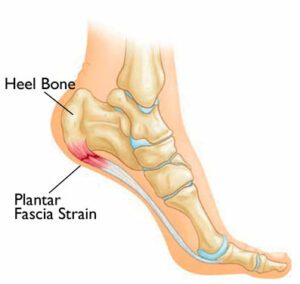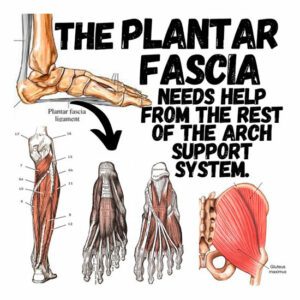
Plantar fasciitis (PLAN-tur fas-e-I-tis) is one of those things you probably never heard of until you were struck down with it, then you discover lots of people you know have suffered from it.
That first few steps in the morning when we feel a pain in our heel, for some of us is just a daily annoyance but for others, it might be something more serious like plantar fasciitis and can often be much more than a little pain.
There are several things you can do to ease the pain of plantar fasciitis and prevent it from getting worse. In this blog post, we will go over what plantar fasciitis is, its common causes, and how you can best manage it.

Plantar fasciitis is one of the most common causes of heel pain. It involves inflammation of a thick band of tissue that runs across the bottom of each foot and connects the heel bone to the toes (plantar fascia). It supports the arch of the foot and absorbs shock when walking or running. Plantar fasciitis commonly causes stabbing pain that usually occurs with your first steps in the morning or after rest periods. As you get up and move, the pain normally decreases at first, but it usually returns after long periods of standing or when you stand up after sitting.
The cause of plantar fasciitis is multifactorial. It is common in runners but also prevalent in people who are overweight. Tension and stress on the fascia can cause small tears. Repeated stretching and tearing of the facia can irritate or inflame it, although the cause remains unclear in many cases of plantar fasciitis.
Risk Factors
Age, certain types of exercise, foot mechanics, and obesity can all increase your risk of developing plantar fasciitis. This condition is most common among people aged 40 to 60. Those engaging in strenuous activities such as running or dancing may be more likely to experience it due to the weight placed on their heel and attached tissue during these exercises. People with flat feet, high arches, or an atypical gait are also susceptible because of the different ways pressure is distributed when standing on one’s feet – this applies to those who struggle with being overweight too!
Occupations that require long periods spent standing up (e.g., factory workers and nurses) could make individuals even more prone since they continue placing stress onto the plantar fascia throughout shift hours day after day
How to reduce the pain
It can take 6-12 months for your foot to get back to normal without any intervention. however, at Step Right, we have had great success in helping people find relief from the pain of plantar fasciitis much quicker
Rest: It’s important to keep weight off your foot until the inflammation goes down. We recommend reducing your weight-bearing activities for approximately two weeks.
Ice: This is an easy way to treat inflammation, and there are a few ways you can use it.

Stretching and exercise: Stretch your calves and Achilles tendon. Your Achilles tendon attaches to the back of your heel bone so tension in your calf muscles can put stress on your injured plantar fascia tissue
Do exercises that make your lower leg and foot muscles stronger. This can help stabilise your ankle, ease pain, and keep plantar fasciitis from coming back.
Athletic tape: Tape can support your foot and keep you from moving it in a way that makes plantar fasciitis worse.
Shoe inserts/Arch supports Also called insoles, arch supports, or orthotics, they can give you extra cushion and added support. You can get them over-the-counter (OTC) or have them custom-made. The arch support helps distribute the weight more evenly throughout the feet, taking stress and pressure off the injured area.
Night splints. Most of us sleep with our feet pointed down, which shortens the plantar fascia and Achilles tendon. Night splints, which you wear while you sleep, keep your feet at a 90-degree angle. So instead of shortening your plantar fascia, you get a good, constant stretch while you sleep.
They can be bulky, but they tend to work really well. And once the pain is greatly reduced, you can stop wearing them.
In conclusion, the more you do to alleviate the tension on the plantar fascia tissue the sooner you can see an end to your planter fasciitis nightmare. Rest and Ice are important in reducing the inflammation associated, and wearing good arch support and the right shoes goes a long way to reducing the tension on the plantar fascia tissue, allowing the body to heal.
At Step Right, we have helped 1000’s of people suffering from plantar fasciitis check us out here to find out more.
© 2025 Step Right. All Rights Reserved.
© 2024 Step Right. All Rights Reserved.